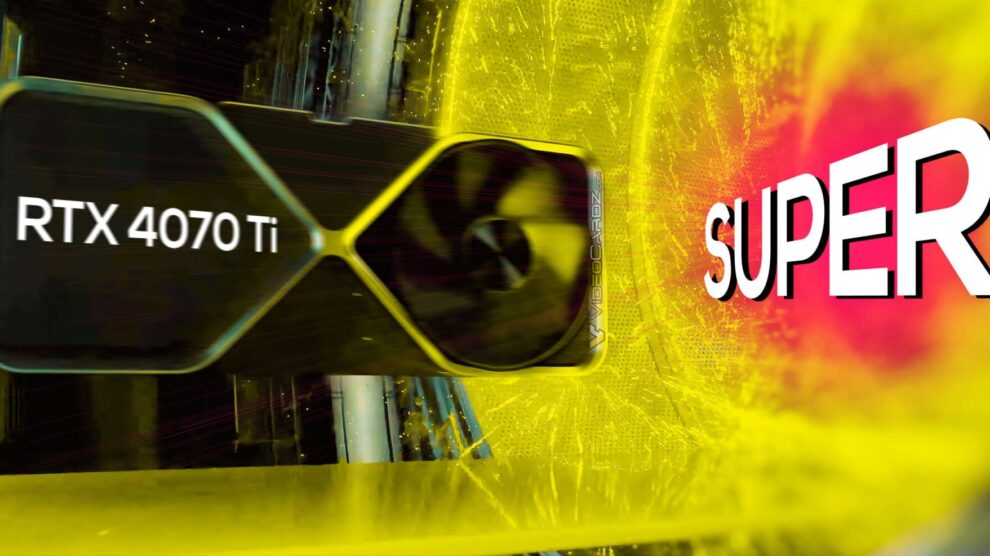Just as dust settled from NVIDIA’s blockbuster GeForce RTX 40-series launch, leaked benchmarks for an unexpected GeForce RTX 4070 Ti SUPER model emerge stirring renewed graphics upgrade speculation despite uncertain value propositions so far.
On paper, this refresh tags merely 10% performance gains over standard 4070 Ti specs. But with no pricing details yet, cost-conscious PC builders ponder whether minor supercharging merits minor-to-major budget upgrades or rather modest iterative stopgaps anticipate true next-generation leaps.
Modest Performance Gains Materialize
Latin hyperbole aside, what exactly does this 4070 Ti SUPER model benchmark bringing to the table?
Leaked preliminary 3DMark gaming performance test scores show roughly 8% faster average framerates over non-SUPER GeForce 4070 Ti models. These come thanks upgraded GPU cores, memory clocks and bandwidth budgets not yet detailed.
However, gains still trail the original RTX 4080 by around 7% despite SUPER naming conventions historically indicating products one tier beneath numbers wearing. This suggests meticulous renaming targeting marketing perceptions lacks true performance backing highest numerical implications.
Unclear Upgradability Value Currently
This means existing GeForce RTX 4070 Ti owners gain little salient motivation upgrading given single digit percentage gains only. And those still awaiting next-generation GPUs face questions whether minor supersized specs warrant even dollar premiums over standard alternatives until costs revealed.
Essentially, the card awkwardly floats between uplifted 4070 siblings and 4080 predecessor territory unclear exactly whom it best entices presently.
Strategic Pricing Shimmy Could Attract Some
Without official pricing details yet, hypothetical value projections remain speculative still. However, rumors suggest NVIDIA shuffles 4070 Ti non-SUPER price points lower synchronized this launch.
In that scenario, the 4070 Ti SUPER possibly represents optimized peak 4070-class performance around original $799 price target while less capable units slide cost-saving scaled downwards as current-generation bargains.
The Best “4070 Ti” Depends Budgets
This allows next-generation PC builders choosing between good-better-best feature sets balancing budgets. Maybe they couldn’t quite afford 4080 territory but appreciate measurable spec bumps over entry-level 4070 now segmented varied price points.
Of course, nothing confirmed until NVIDIA juxtaposes SUPER against non-SUPER 4070 SKUs transparently. Gamers await pricing clarity determining if minor performance envelop pushes possibly unnecessary towards overkill diminishing returns.
Wildcards Beyond Pure Performance
Reviewing leaked synthetic gaming benchmarks alone risks overlooking potential SUPER model wildcard advantages beyond just similar-to-4080 speeds exactly.
NVIDIA perfected successful SUPER launches before bundling desirable improvements into refresh portfolios beyond frames-per-second alone.
Sometimes small spec increases pair bigger picture perks like quieter cooling, updated ports and connectivity, or enhanced software suite adds together amplifying at-a-glance appeal.
The Importance of Value Perception
Reasonable pricing holds the ultimate key convincing convenient improvements merit tangible dollar premiums over previous-generation hardware.
But NVIDIA cultivation of premium complementary technology images significantly sways purchase justification if performance deltas themselves underwhelm paper-thin transparency otherwise.
Expect insightful reviewers determining true value equations beyond misleading superficial naming façades that could distort consumer graphics card market perceptions and educated decisions otherwise.
To SUPER or Not to SUPER?
Ultimately the GeForce RTX 4070 Ti SUPER lands in no-man’s land currently pleasing few unambiguously until stores list official model pricing concretely.
Neither hardcore PC enthusiasts chasing high benchmark conquests nor budget-conscious value shoppers feel obvious target audiences given mysterious added cost schedulings still.
And historically when audiences scratch heads wondering deeply specific niche products fill, odds lean gimmicky rather than game-changing too often.
The Bigger Picture and Ethical Quandaries
Stepping back, enthusiasts also question whether NVIDIA risks oversaturation diluting individual GPU model clarity with constant SUPER-ized, TI-fied and other suffixed derivatives that could artificially complicate simple performance tier mental models.
If nuances overwhelm and margin differences minimize while prices maximize, the once-predictable video card market risks baffling consumers losing easy orientation equals losing sales and brand reputation.
We encourage NVIDIA clarifying segmented naming schemas and cost structures that empower purchasers navigating optimal card decisions for their exact use cases and budgets accordingly.










Add Comment